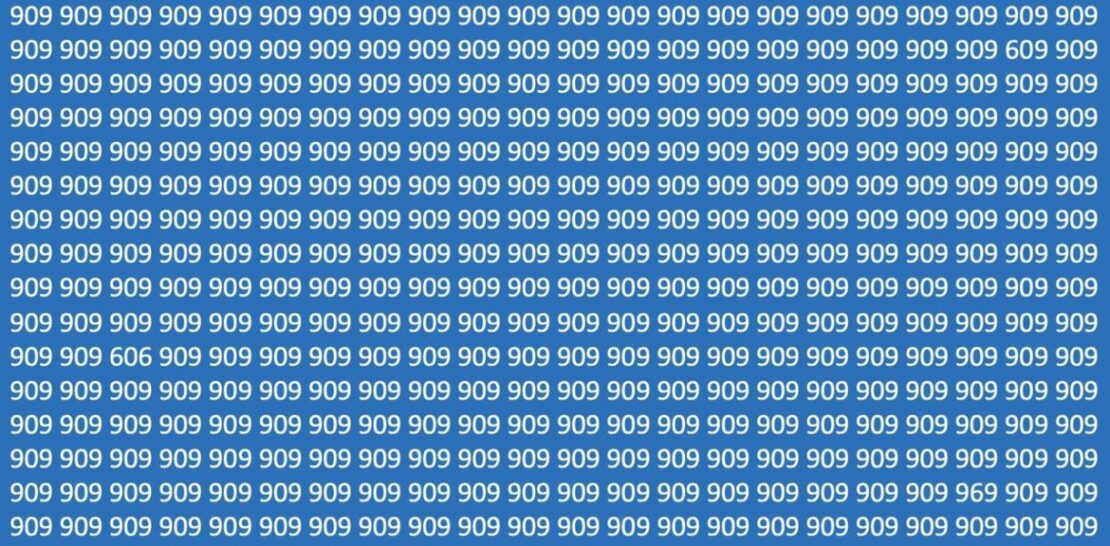It’s not every day that you come across a challenge that captivates you and pushes your mental abilities to the limit.
The Visual IQ Test that revolves around finding the four different numbers of 909 within a time limit of 20 seconds has become a fascinating topic for language specialists, cognitive scientists, and puzzle enthusiasts alike.
This enigma, which has reportedly been solved by only 5 out of 100 people, has sparked a multitude of questions about the nature of intelligence, the human brain’s capacity for pattern recognition, and the role of language in problem-solving.
In this exhaustive article, we will delve deep into the intricacies of the 909 Visual IQ Test, dissecting its structure, exploring pattern recognition and language processing, and unveiling valuable insights into the cognitive processes that drive our ability to solve such problems.
The Anatomy of the 909 Visual IQ Test
To begin our journey, we must first dissect the test itself and understand the factors that contribute to its intriguing nature.
Essential Components of the Test
- Numbers: At the core of the test lies the number 909, which is presented in a visually engaging manner. It is composed of four distinct numbers, which are the primary elements that participants must identify within the 20-second time limit.
- Time Constraint: The 20-second time limit adds a layer of complexity, prompting participants to think quickly and efficiently. This constraint has been carefully chosen to challenge participants and provoke a sense of urgency that is crucial for assessing one’s cognitive abilities.
- Visual Presentation: The test employs a visual layout that can be both stimulating and challenging, requiring individuals to process information at a rapid pace and make connections based on pattern recognition and problem-solving skills.
Why the 909 Visual IQ Test is Intriguing
- The test is unique in that it combines elements of both language and mathematics, requiring participants to engage multiple cognitive faculties in order to solve the puzzle.
- The test challenges our preconceived notions about intelligence and problem-solving, urging us to question the boundaries of our abilities and the true nature of intelligence itself.
- The test has an air of mystery and exclusivity, as only a small fraction of participants have been able to solve it within the given time constraint. This factor adds to the intrigue and allure of the 909 Visual IQ Test.
Pattern Recognition: The Key to Unlocking the 909 Visual IQ Test
One of the most crucial aspects of tackling the 909 Visual IQ Test lies in understanding and mastering pattern recognition.
Pattern Recognition: A Cognitive Process
Pattern recognition is a fundamental cognitive process that allows us to identify, categorize, and process the various stimuli we encounter in our environment. It is essential for a wide range of tasks, from recognizing faces to understanding language, and plays a critical role in problem-solving. In the context of the 909 Visual IQ Test, pattern recognition serves as the primary mechanism through which participants can discern the different numbers embedded within the test.
Strategies for Enhancing Pattern Recognition
- Chunking: Breaking down the test into smaller, more manageable segments can facilitate the identification of relevant patterns and help individuals process the information more efficiently.
- Mental Rotation: By mentally rotating the test’s visual presentation, participants can approach the problem from different angles, allowing them to uncover hidden patterns and relationships among the numbers.
- Attentional Focus: Focusing on specific regions of the test can help participants filter out irrelevant information and zero in on the patterns that will ultimately lead them to the correct answer.
Language Processing and the 909 Visual IQ Test
Another critical factor in solving the 909 Visual IQ Test is the role of language processing, which enables us to make sense of the test’s visual presentation and uncover its hidden secrets.
Language Processing: A Multifaceted Cognitive System
Language processing is a complex cognitive system that encompasses a range of sub-processes, including phonological, morphological, syntactic, and semantic processing. These sub-processes work in tandem to allow us to comprehend and produce language effectively. In the context of the 909 Visual IQ Test,language processing plays a pivotal role in helping participants decode the numerical information presented visually and formulate a coherent solution to the problem at hand.
How Language Processing Facilitates Problem-Solving
- Symbolic Representation: Language processing allows us to represent the numbers in the test symbolically, enabling us to manipulate and analyze the information more effectively.
- Working Memory: Our working memory, which is closely tied to language processing, helps us retain and manipulate the information presented in the test, allowing us to identify patterns and generate solutions.
- Verbal Reasoning: The ability to reason using language is crucial for understanding the relationships between the numbers and determining the correct answer to the 909 Visual IQ Test.
Unlocking the Secrets of the 909 Visual IQ Test: Cognitive Strategies and Techniques
With a deeper understanding of pattern recognition and language processing, we can now turn our attention to the cognitive strategies and techniques that can be employed to conquer the 909 Visual IQ Test.
Cognitive Strategies for Tackling the 909 Visual IQ Test
- Active Processing: Engaging in active processing, such as verbalizing the numbers or writing them down, can help individuals retain and manipulate the information more effectively, ultimately leading to a higher likelihood of success.
- Visualization: Creating mental images of the numbers and their relationships can facilitate pattern recognition and aid in the problem-solving process.
- Systematic Approach: Adopting a systematic approach to the test, such as scanning the visual presentation methodically or using a process of elimination, can help individuals stay focused and organized, increasing their chances of identifying the correct answer.
Adopting the Right Mindset
In addition to employing these cognitive strategies, it is also essential for participants to adopt the right mindset when approaching the 909 Visual IQ Test. Embracing a growth mindset, which emphasizes the belief that intelligence and problem-solving abilities can be developed through effort and perseverance, can help individuals maintain motivation and remain undaunted by the challenges posed by the test. Moreover, cultivating a sense of curiosity and openness to new experiences can foster creative thinking and enhance one’s ability to tackle complex problems like the 909 Visual IQ Test.
In conclusion, the 909 Visual IQ Test is a fascinating and enigmatic puzzle that has captivated the minds of language specialists, cognitive scientists, and puzzle enthusiasts alike. By dissecting the test’s structure, exploring the cognitive processes of pattern recognition and language processing, and unveiling the strategies and techniques that can be employed to tackle the test, we have gained valuable insights into the human brain’s capacity for problem-solving and the true nature of intelligence. Armed with this knowledge, we can approach the 909 Visual IQ Test with newfound confidence and curiosity, eager to unlock its secrets and challenge the boundaries of our cognitive abilities.




